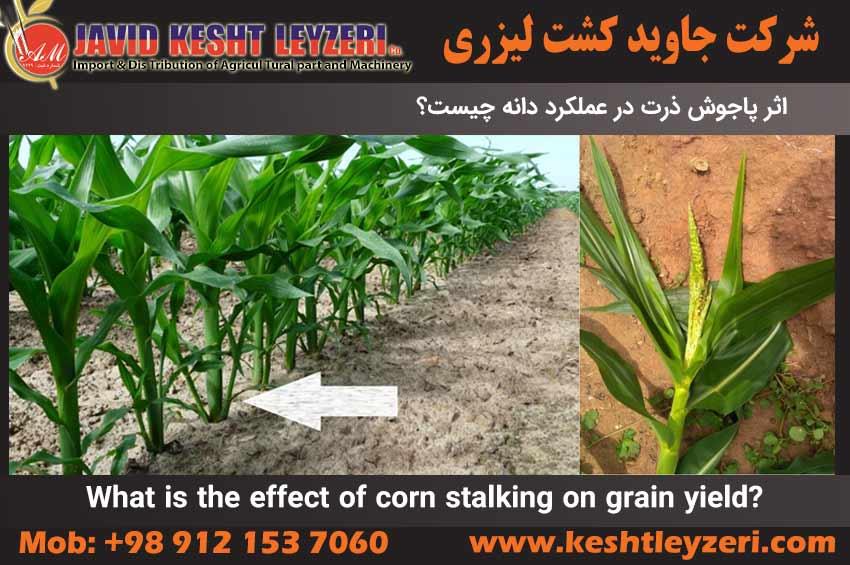
What is the effect of corn stalking on grain yield?
javid keshtleyzeri Co.ltd
In the past, when farmers observed the flourishing of Pajush in their hybrid corn fields, they were more concerned about its negative effect on corn yield. It was a common belief that during the formation of leaf litter, the nutrients of the main plant are wasted, and as a result, the yield of the crop is reduced. Therefore, the pajosh were known as "competitors" and many farmers tried to remove them from their fields. But research has shown that pajosh generally has little effect on corn grain yield, and overall its effects are beneficial.
List of contents of this section:
What is corn pajosh?
What are the factors that cause corn blight?
Does the corn plant benefit from Pajush?
What are the cultivars that are susceptible to the formation of pajosh?
What is the effect that pajosh occurs in response to physical damage to the stem?
In the following, the above contents are presented.
What is corn pajosh?
The stem leaf or stem drooping is formed in the subsoil level from 5 to 7 lower nodes on the corn stem. Pajushs give separate formations of root system, stem, nodes, internodes, leaves, cobs and tassels. However, the vascular connection between the tiller and the main stem of corn is maintained. Buds may form at any node of the corn stalk below the soil, but the number of pods produced in corn depends most of all on the distance between plants in the crop row, plant density in the field, moisture content, and soil fertility, especially in the first few weeks. The growing season and the genetics of the corn cultivar are dependent. In fact, under ideal conditions, the corn plant is able to form cobs and usually cobs can be seen at the 6-leaf stage of corn.
What are the factors that cause corn blight?
One of the causes of corn wilt may be the reduction of the corn population compared to the yield potential in that field. However, when the weather conditions are right, the corn plant will have enough energy and nutrients to produce pajoosh. Almost all corn hybrids, when nutrient and moisture conditions are ideal, may produce one or more tillers in low-density crop rows or at the ends of low-density field rows. However, some maize cultivars with the right genetic background may form one or more tillers under fertile and humid conditions, even at high field densities. However, the process of corn breeding in the past years has minimized the number of corn borers by selecting resistant cultivars.
Does the corn plant benefit from Pajush?
Several studies have been conducted to investigate the relationship between tiller and main stem in corn plants. Defoliation experiments in corn showed that in corn with pajosh, all leaves were almost twice as many as in corn without pajosh, but the amount of seed production was about the same. This result shows that there is an adhesive relationship between the panicle and the main stem in corn, and the sugars produced in the panicle leaves are transferred to the grain in the main stalk. In more recent studies, it has also been shown that the transfer of plant sugars from the main plant to the stalk before the tassel stage is very low. However, after the tassel stage in maize and during the grain filling stages, a significant amount of plant sugars are likely to be transferred from the sessile panicles to the main stem. But when both the scion and the main stem have stems, the transfer of plant sugars between the scion and the main stem is much less frequent. In fact, in this case, the main plant and the follower work separately, keeping the sugars produced in their leaves in their stems.
What are the cultivars that are susceptible to the formation of pajosh?
If a particular hybrid has the ability to not only show high yield potential, but is also widely susceptible to leaf spot formation, it is better not to avoid growing that hybrid. In general, the scion usually grows a bit later than the main stem and falls behind in competition with the main stem for water, nutrients and light. This leads to the production of incomplete, misshapen, or bald patches. Therefore, the cob that may be formed in the pods will have no effect on the growth of the main plant. It should be noted that the formation of excessive clumps can indicate problems in the density and distribution of plants in the field. If the formation of pajush takes place in low-density rows or fields with plant density less than the optimal position, it is better to take measures to improve the cultivation conditions in the field in order to achieve optimal yield. Also, research has shown that weeds do not have a negative effect on corn yield and can indicate suitable growing conditions in the field. Hence, Pajush can only be effective in yield when the main stem is damaged or the crop density is much lower than recommended.
What is the effect that pajosh occurs in response to physical damage to the stem?
When the main stalk of corn is damaged in the first stage of the season, such as being scratched or destroyed due to breakage, frost, pests, wind, tractors, falling people, or diabetes poisoning, usually one or more pajoush is formed. If damage occurs early in the growing season, it may result in a bushy form with harvestable ears. But late bloomers will generally not have enough time to produce ears before the last investment event. We have had such conditions in the last few years in the state of Indiana. In this incident, many lands were destroyed due to strong wind and the pajushs that had already formed compensated for the damage. But in practice, a small amount of food was obtained from these damaged fields.
It should be noted that in very rare cases, corn wilt may be caused by internal grain white disease (trophin wilt) or "step crown". The cause of this disease is the fungus Sclerophthora macrospo
ra and grows stronger in areas with poor drainage. This fungal disease leads to the bad shape of the vegetative and reproductive parts of the plant by stopping growth and producing immature and incomplete cobs, some of which have seeds or no seeds at all, and in some cases, panicles appear. Although the disease can be transmitted through seeds, the probability of spreading it through seeds is very low. As a result, it is not expected that the diseases caused by this fungal disease will increase the yield of the saffron product.
As a general rule, the formation of spurs in a corn field without physical damage to the main stem does not have a significant effect. Recent research has shown that removing pajosh has only a small effect on corn grain yield. Usually, the main stem outcompetes the shoots for resources, and eventually the shoots dry up. But if the field is damaged or has a very low density, the formation of pajush can help the production of cobs and increase the grain yield.
The formation of spikes is a natural part of corn physiology and often occurs under favorable growth conditions. Generally, the main stem is fed by the leaves and this does not harm it. Pajosh formation is a sign of less density in the field than the current yield potential. Also, in some cases scion may be formed after damage to the main stem early in the season, which can be beneficial.






